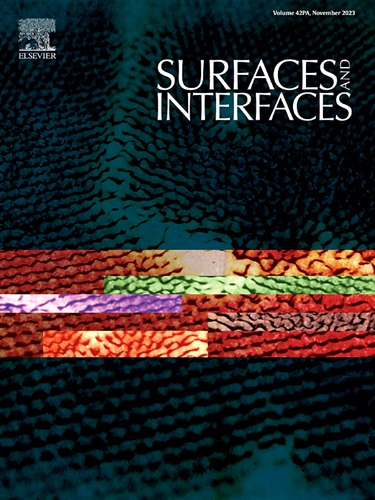Fabrication of Eu3+/Tb3+-co-doped zirconia electrospun nanofibers as a multicolored photoluminescence sensor for the determination of levodopa
IF 6.3
2区 材料科学
Q2 CHEMISTRY, PHYSICAL
引用次数: 0
Abstract
In this study, ZrO2:Eu3+:Tb3+ nanoparticles were synthesized by a microwave-assisted approach to determine levodopa, the precursor of the neurotransmitter dopamine. Dopamine, as a catecholamine, can pass across the blood-brain barrier to enter the central nervous system and treat Parkinson's disease. The identification of levodopa's harmful effects has enabled the development of a variety of analytical approaches. The fluorescence sensor was employed in this study due to its advantageous characteristics, including precise measurement capabilities and rapid response times. Fourier transform infrared spectroscopy, X-ray diffraction, X-ray photoelectron spectroscopy, field emission scanning electron microscopy, energy-dispersive X-ray spectroscopy, high-resolution transmission electron microscopy, diffuse reflectance spectroscopy, and UV–vis and fluorescence spectrophotometers were employed to examine the optical, microscopic, and spectroscopic characteristics of these nanoparticles. The sensor's efficiency was evaluated by detecting levodopa with a recovery percentage of 86–99 % in human blood serum and 97–102 % in urine from actual human samples. The mechanism in the interaction between levodopa and nanoparticles was explored using UV–vis spectroscopy, which indicated that the PET mechanism was responsible for the observed quenching. The sensitivity of the sensor was also determined by the lowest detection limit of 91 nM, which was achieved by examining the effects of levodopa on the sensor in the linear range of 1–100 µM. Furthermore, the sensor exhibited excellent stability and selectivity. The sensor was constructed using electrospun polyacrylonitrile (PAN) nanofibers, which were deemed more innovative and practical than paper substrates. Additionally, an orange-emitting ZrO2:Eu3+:Tb3+ sensor based on PAN was employed to assess levodopa visually.

Eu3+/Tb3+共掺杂氧化锆静电纺丝纳米纤维的制备及其在左旋多巴检测中的应用
本研究采用微波辅助方法合成了 ZrO2:Eu3+:Tb3+ 纳米粒子,以测定神经递质多巴胺的前体左旋多巴。多巴胺作为一种儿茶酚胺,可以通过血脑屏障进入中枢神经系统,治疗帕金森病。为了确定左旋多巴的有害作用,人们开发了多种分析方法。由于荧光传感器具有精确测量能力和快速响应时间等优势特点,本研究采用了荧光传感器。本研究采用了傅立叶变换红外光谱、X 射线衍射、X 射线光电子能谱、场发射扫描电子显微镜、能量色散 X 射线能谱、高分辨率透射电子显微镜、漫反射光谱、紫外可见光分光光度计和荧光分光光度计来检测这些纳米粒子的光学、显微和光谱特性。通过检测人体血清中的左旋多巴和尿液中的左旋多巴,评估了传感器的效率,其回收率分别为 86%-99% 和 97%-102%。利用紫外-可见光谱探究了左旋多巴与纳米颗粒之间的相互作用机制,结果表明 PET 机制是造成所观察到的淬灭现象的原因。通过检测左旋多巴在 1-100 µM 线性范围内对传感器的影响,该传感器的最低检测限为 91 nM,从而确定了传感器的灵敏度。此外,该传感器还具有出色的稳定性和选择性。该传感器采用电纺聚丙烯腈(PAN)纳米纤维制成,与纸质基底相比更具创新性和实用性。此外,基于 PAN 的橙色发光 ZrO2:Eu3+:Tb3+ 传感器还被用来直观评估左旋多巴。
本文章由计算机程序翻译,如有差异,请以英文原文为准。
求助全文
约1分钟内获得全文
求助全文
来源期刊

Surfaces and Interfaces
Chemistry-General Chemistry
CiteScore
8.50
自引率
6.50%
发文量
753
审稿时长
35 days
期刊介绍:
The aim of the journal is to provide a respectful outlet for ''sound science'' papers in all research areas on surfaces and interfaces. We define sound science papers as papers that describe new and well-executed research, but that do not necessarily provide brand new insights or are merely a description of research results.
Surfaces and Interfaces publishes research papers in all fields of surface science which may not always find the right home on first submission to our Elsevier sister journals (Applied Surface, Surface and Coatings Technology, Thin Solid Films)
 求助内容:
求助内容: 应助结果提醒方式:
应助结果提醒方式:


